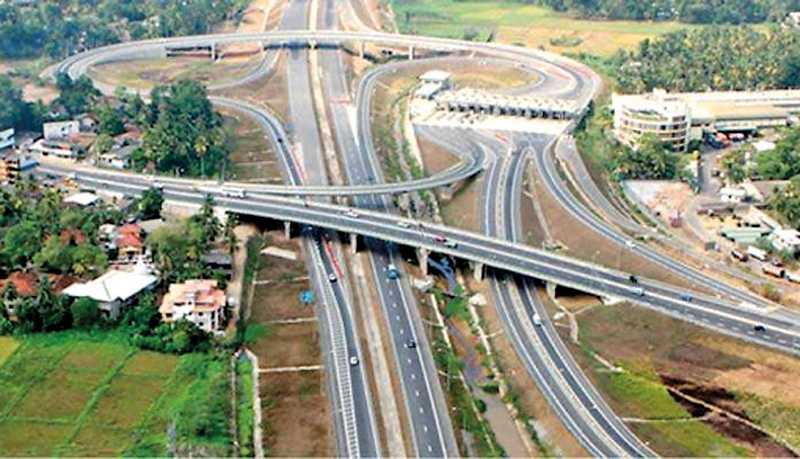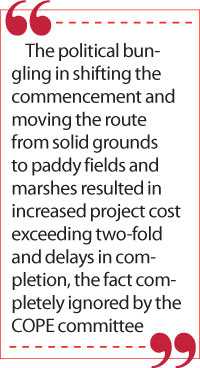Tuesday Dec 09, 2025
Tuesday Dec 09, 2025
Thursday, 7 January 2021 00:01 - - {{hitsCtrl.values.hits}}

The Central Expressway project will go down in history as the most messed up highway construction project
 Introduction
Introduction
Recently COPE (Committee on Public Enterprises) revealed massive irregularities in the construction of Central Expressway running into billions of rupees, allegating more than Rs. 1.7 billion was spent on feasibility studies. In addition, the delay in commencement of the first section of the Central Expressway, from Kadawatha to Mirigama, from 2015 to 2019, had caused a financial loss of Rs. 8 billion.
It was alleged that changing the original plan to commence the road from Kadawatha, instead of Enderamulla to Mirigama by a Cabinet decision in 2015, had required a new feasibility study, carried out by SMEC Consultants was expensive. Also the construction work on the first 5 km section was delayed for four years due to a payment issue and work commenced only in late 2019. The COPE also disclosed that while other sectors stagnated, Mirigama to Kurunegala sector is 75% completed.
The COPE committee commented only on happenings after 2015, after Yahapalanaya Government took over, possibly due to its legal limitations confined to activities of the last Government, but the Central Expressway, then called Kandy Expressway commenced long ago and remarks by COPE committee without considering early happenings would be unfair.
Looking into previous happenings would disclose how interferences by the politicians serving their own objectives, delay important projects resulting massive cost escalations borne by the citizens, are discussed below.

History
An expressway to Kandy originating from Kadawatha was proposed and the Swedish Consultant presented the feasibility report in December 2001. According to the proposal, the expressway will commence from the Kadawatha interchange of Outer Circular Road terminating at Katugastota. The selected corridor lies close to Ganemulla, Gampaha, Mirigama and Ambepussa (Phase 1 – 48.2 km) and Rambukkana, Hatharaliyadda, Hedeniya, Katugastota (Phase 2 – 50.7 km), a total distance of 98.9 km. Also, a 12-km ring road around Kandy city from Katugastota to Gannoruwa.
The offer and award of MOU
The proposed highway was offered to international investors in May 2011, to be built as a privately financed toll road on BOT (build, own and transfer) basis. The investor would design the road within the selected road corridor, build the highway and operate without funding from the Government, costs to be recovered with collected toll charges for an agreed time period. The Cabinet approved the award the construction of 100 km Kandy Expressway to two Chinese companies, China Merchant Holdings and China Merchant Huajin Investment Company in July 2012, and a MOU was signed.
The Chinese agreed to construct the Kadawatha-Ambepussa section for a 35-year BOT period and construction was expected to begin in August 2012. The Chinese indicated that the second sector, Ambepussa-Kandy, would require a longer period. The design and construction would be under the supervision of Australian consultant SMEC Engineering.
Change of route
With the construction of highway eminent, in July 2012 villagers near Gampaha protested against the loss of their property, Minister Felix Perera agreed to discuss with the President to relocate the route. President Mahinda Rajapaksa having abandoned Hambantota and wishing to move over to Kurunegala district, was prepared to accommodate wishes of local MPs. The highway route was modified, moving the commencement of highway from Kadawatha to Enderamulla. The President advised the RDA officials to amend the route accommodating MPs wishes, also to avoid demolition of houses. The President renamed the road as Central Expressway.
At the time, extension of Outer Circular Road to join Katunayake expressway from Kadawatha to Kerawalapitiya (K-K road) was ready for construction. With Central Expressway scheduled to commence from Enderamulla, the Kadawatha-Enderamulla sector had to be redesigned as a 6 lane highway to accommodate additional traffic expected in Central Expressway.
Enderamulla is surrounded by marshes and the amended route traversing over paddy and marshy lands, needing lengthy viaducts. Viaducts cost over six times the cost of a firm-ground road and the increased costs altered the financial viability of the project, and the Chinese investor was no longer interested.
With the commencement of proposed Central highway being shifted from Kadawatha to Enderamulla, road to Ambepussa via Mirigama would be 52.5 km. Earlier Ambepussa was 48.2 km thus increasing the distance by five kms. In addition Kadawatha to Enderamulla would add further 5 km, increasing the distance from Kadawatha to Mirigama by 10 km.
Kadawatha to Kerawalapitiya
The joining of Outer Circular Road with Katunayake highway was aimed with the 9.3 km long Kadawatha to Kerawalapitiya highway. The route passes over mostly low lying lands and marshes, with 6.3 km of the 9.3 km road being constructed on columns, resulting the highest cost per km. The highway construction was awarded in January 2013 to China Metallurgical Group Corporation at a value of Rs. 66.9 billion. But the construction commenced only in October 2014, after signing the loan agreement with the Exim Bank of China in September 2014.
Central Expressway
With the change of route in 2013, the renamed Central Expressway, included 4 stages.
President MR inaugurated Stage 1 in 2013 by laying a foundation stone at Meerigama. In addition, on 14 December 2014 the President launched the construction of the expressway to Kandy by laying a foundation stone at the Senkadagala entrance. The total cost of the expressway was estimated to be approximately Rs. 200 billion and the works were scheduled to be completed by 2018.
Change of government and routes
With the change of government in early 2015, the new government re-accessed the Kadawatha-Kerawalapitiya road, also the Enderamulla-Mirigama sector of Central highway. Having realised the extremely high cost of Enderamulla-Mirigama sector due to marshlands, in October 2015 the Cabinet approved the commencement of Central Expressway be brought back to Kadawatha.
With the modification of Kadawatha-Enderamulla sector of K-K road, road width could be reduced from 6 to 4 lanes similar to balance section. Also the Enderamulla interchange would become redundant. Reducing the road width and the interchange would reduce the costs by Rs. 23.93 billion or 35.9% of total cost.
But the cost reduction was challenged by the contractor resulting a dead-lock. After years of negotiations the savings were agreed as around 15% and project cost reduced only by around Rs. 10 billion, less than half that was anticipated originally. Finally the highway was opened to traffic in November 2019.
Slow progress
The Government in 2015, awarded the first 5 km of the Central highway, Kadawatha to Kossinna section to Metallurgical Corporation of China, the same contractor as K-K road. But the cost to be covered with the expected Rs. 23.93 billion savings from the Kadawatha-Enderamulla sector. But MCC and the Exim Bank were not agreeable. In addition, the Government offered the Kossinna-Meerigama 32.5 km section valued Rs. 145.8 billion to the contractor, thus effectively MCC became the contractor for entire Section 1 of Central Highway.
The funding contract arranged with EXIM Bank covered 85% of the contract price of $ 989 million. But a loan condition was for the release of Chinese funds, RDA had to advance the balance 15%. Due to non-release of the local component, entire funding got withheld and progress got affected.
Finally, RDA released the 15% component of advance payment amounting to Rs. 16.67 billion on 25 August 2020 after a delay of over five years.
Expressways under Ranil Wickremesinghe
After the change of government in 2015, the Central Expressway commencing from Kadawatha was inaugurated again by PM Ranil Wickremesinghe on 3 August 2015, by unveiling a plaque at Kossinna. Also in February 2017 PM launched the 39.7 km long second sector from Mirigama to Kurunegala with the Ambepussa link to be completed by 2021. The construction of Phase 2 was awarded to local construction companies for the first time in Sri Lanka.
In February 2018 PM Ranil W, with Cabinet acceptance awarded the contract for Section 3 of the Central Expressway to M/s Taisei Corporation, with funding from Bank of Tokyo Mitsubishi. But the two parties due to conflicts, had to revoke the contract.
Section 2
Mirigama to Kurunegala road with Ambepussa link (Section 2) was awarded to local contractors with funding from state banks. But with utilisation of total allocation, in late 2020 the Treasury refused to guarantee further loans for RDA, thus holding payments to contractors, delaying progress.
Meanwhile, the Ministry of Highways proposes to bring all expressways under a single authority, so that annual toll collections from the expressways could be used as security in obtaining loans.
Section 3
With the mountainous terrain, the 32.5 km Section 3 from Pothuhera to Galagedara is the most difficult and expensive road section. The section includes four interchanges, three tunnels each over 200 m long, 12 main bridges and 17 viaducts across the floodplains of three rivers; Rambukkan Oya, Kuda Oya and Kospothu Oya.
Current situation
When MR changed the scope of Central Expressway, the first three sections were expected to be completed by 2018. Today the entire project is seriously delayed, also funding requirements keep on mounting.
Kadawatha to Mirigama Section was awarded in 2015, but funding was finalised only in August 2020 and the completion may take another two-and-half years. The Section 2 from Meerigima to Kurunegala was constructed by local contractors with funds from local banks. It was due to be completed in November 2020, current indications are May 2021, but funding would remain an issue.
The construction of Phase 3 from Pothuhera to Galagedara is delayed by almost four years. Now, with the policy of avoiding foreign loans the Minister says projects would not be awarded to foreign contractors and this could lead to problems. The tunnels in the sector would require two tunnels either way, each with two lanes would be most complicated, as local contractors are yet to execute even smaller tunnels for hydro-power projects.
Messed up highway projects
The Central Expressway project would go down history as the most messed up highway construction project. The project commenced as an expressway to Kandy, the heaviest trafficked road in the country, was accepted by two Chinese companies to construct the highway without any financial burden to the country, getting payment based on toll collection.
But the entire scenario changed when President MR wished to accommodate wishes of local politicians and moved the road closer to their cities. In addition, shifting of commencement from Kadawatha to Enderamulla, which is surrounded by marshes making construction expensive.
The shifting of the highway in 2013 resulted in redesign of the entire highway route, especially with MR’s instructions to avoid disturbing local residents. Although President MR laid foundation stones, construction was not possible until the designs were finalised by the consultants, environmental acceptance, funding and award of contracts after calling tenders. A procedure completely ignored by the COPE committee.
Route selection
Kurunegala district is the most convenient region for road construction, generally flat terrain, sparsely populated except near towns resulting in cheap highways. But the President’s instructions to avoid disturbing population, which RDA engineers obeyed to the very letter made the highway move over paddy fields and marshes.
Section 2 is constructed by a number of local contractors, the progress is shown in RDA progress reports, which include an ariel view of each road available over the internet. A notable feature is the route passing over paddy fields and marshes. Crossing marshes requires viaducts, an elevated road built over piles. In addition, road over paddy fields require over 5 m high earth filling to enable crossing of local roads. Rerouting would have pleased politicians and locals, but at the expense of the citizens.
The modifications increased the highway cost nearly three-fold, which could have been avoided if a proper compensation payment system for demolished housing were offered for the earlier selected route.
Bringing back the commencement to Kaduwela
When the road commencement was shifted to Kaduwela (a correct decision) RDA engineers failed to judge the savings, which was thought as sufficient to construct 5 km of Mirigama highway. Although Exim Bank agreed to fund the highway to Mirigama, the loan condition required RDA’s contribution of 15% to release the loan. For some reason for five years the Government refused to release funds delaying the project. Changes to contract scope and non-availability of funds leads to variations to contract, which contractors love as a means of getting extra payments from the client.
Variations to contract
When a Contractor signs an agreement with a Client, both parties are bound by the contract. When conflicts occur, major contracts are bound by the Conditions of Contract detailed in FEDIC (Fédération Internationale Des Ingénieurs-Conseils) the French term for International Federation of Consulting Engineers.
The changes made to K-K road by reducing the Kadawatha-Enderamulla sector from six lanes to four lanes, also deleting the Enderamulla interchange were major changes to the contract. RDA Engineers conveniently declared the savings on the contract from six lanes to four lanes as Rs. 23.93 billion, which was challenged by the contractor.
Normally, the contractor is paid for the permanent works done as per Bill of Quantities. Building an elevated highway on piers supported on piles driven to the rock below. The process requires making a temporary road involving filling the marsh, with brought in soil to allow movement of machinery and equipment. These temporary works are not measured, but costs are reflected in items in the BOQ. These temporary works are so expensive that an elevated road costs over six times over a road on dry land.
After accepting the contract, the contractor’s first job would be the temporary access road, sufficiently wide to accommodate the six-lane highway. When the scope was reduced the contractor would have completed a fair amount of access road and expects the additional works be paid, as covered under FEDIC conditions.
COPE committee remarks
COPE committee is filled with politicians and are unaware of Conditions of Contract or FEDIC. In addition they may be bound by limitation beyond 2015, making changing the highway commencement to Enderamulla beyond their investigations.
COPE was concerned with over Rs. 1.7 billion payments made to SMEC consultants. But when the highway route is modified to and fro, consultant’s scope increases and the consultant would convert same to their advantage.
COPE also was concerned of delays in Kadawatha to Mirigama, during 2015 to 2019, had caused a financial loss of Rs. 8 billion. But overlooked the fact that highway to Kandy could have been executed by Chinese investors many years ago without any cost to the country. Afterwards, extending the highway to Kurunegala and Dambulla could have been offered under same terms, possibly to a different investor.
The political bungling in shifting the commencement and moving the route from solid grounds to paddy fields and marshes resulted in increased project cost exceeding two-fold and delays in completion, the fact completely ignored by the COPE committee.
The country is facing a severe foreign exchange and local fund shortage has already delayed payments to contractors, affecting progress. The Mirigama to Kurunegala sector could be opened in a few months provided funds are released on time. But joining Kurunegala with other expressways in the country depends on completion of Kadawatha to Mirigama sector, which would be at least a few years away, if loans currently agreed on are sufficient, which is doubtful. Highway to Kandy which was originally proposed is beyond imagination.